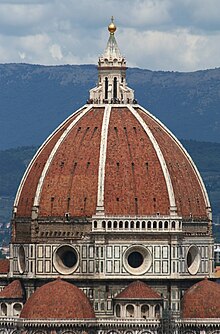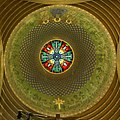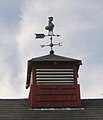Cupola

In architecture, a cupola (/ˈk(j)uːpələ/)[1] is a relatively small, most often dome-like, tall structure on top of a building.[2] Often used to provide a lookout or to admit light and air, it usually crowns a larger roof or dome.[3][4]
The word derives, via Italian, from lower Latin cupula (classical Latin cupella), from Ancient Greek κύπελλον (kúpellon) 'small cup' (Latin cupa), indicating a vault resembling an upside-down cup.[a]
Background
The cupola evolved during the Renaissance from the older oculus. Being weatherproof, the cupola was better suited to the wetter climates of northern Europe. [citation needed] The chhatri, seen in Indian architecture, fits the definition of a cupola when it is used atop a larger structure.[citation needed]
Cupolas often serve as a belfry, belvedere, or roof lantern above a main roof. In other cases they may crown a spire, tower, or turret.[4] Barns often have cupolas for ventilation.[5][6]
Cupolas can also appear as small buildings in their own right.
The square, dome-like segment of a North American railroad train caboose that contains the second-level or "angel" seats is also called a cupola.[7][8]
Gallery
-
Cupolas on the towers of Montefiascone Cathedral, Italy.
-
Ribbed cupola crowns the minaret of the Mosque of Uqba, in Kairouan, Tunisia.
-
Inside of Armenian Orthodox church cupola in Lviv, Ukraine.
-
Cupolas were also used on some old barns for ventilation.
-
View from the interior of the Cupola module on the International Space Station.
-
Trompe-l'œil painting of a cupola in a church in Northern Italy (Brivio)
-
A cupola-style caboose with an "angel seat" above
See also
Notes
References
- ^ "cupola". Merriam-Webster.com Dictionary.
- ^ "Glossary of Architectural Terms - C". Archiseek: Online Architecture Resources. Archived from the original on 27 December 2008. Retrieved 3 January 2009.
- ^ "cupola". The American Heritage Dictionary of the English Language (5th ed.). HarperCollins. Retrieved 2015-04-26.
- ^ a b "Just what is a cupola anyway?". Cupola Consulting. Retrieved 3 January 2009.
- ^ "What is a cupola and why do barns have them?". 17 March 2014. Retrieved 15 November 2015.
- ^ Active Interest Media, Inc. (November 1980). "Old-House Journal". Old House Journal. Active Interest Media, Inc.: 177. ISSN 0094-0178.
- ^ "Railroad Dictionary: A". CSX.com. CSX Transportation. Archived from the original on 1 August 2015. Retrieved 18 September 2014.
- ^ Zabel, Darcy (2005). The (Underground) Railroad in African American Literature. Peter Lang. p. 5. ISBN 9780820468167.









